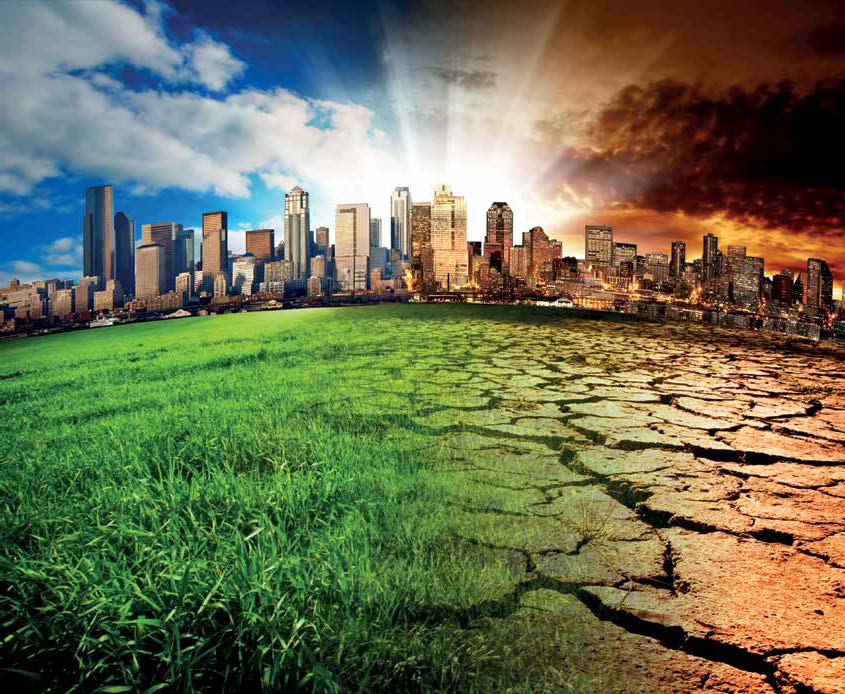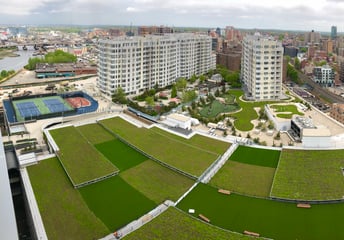Apart from their main purpose, all public buildings have a representative function in our built environment. They reflect the main values and aspirations of their builders - even more so, when the public buildings represent municipal or state functions. In this day and age, when many public institutions and private companies are compelled to form environmental strategies and goals in their line of work, it is important to remember that our built infrastructure can contribute a lot to reaching those goals.
Reducing energy use and air pollution are two major challenges we face in the developed world. Buildings account for 39% of the total US and 40% of the European Union’s energy consumption. Additionally, air pollution negatively affects our quality of life and health conditions. (1) Originating in Germany more than 40 years ago, green roof technology is now considered to be a widely accepted and sustainable strategy for improving building performance and helping to mitigate the effects of climate change. (2)
INVESTING IN GREEN ROOFS FOR PUBLIC BUILDINGS
When convincing investors, economic arguments are still the most important. The term “natural capital” has been developed to explain the economic value of sustainable solutions. The term helps to quantify the financial savings that can be made by investing in natural flood protection, climate change mitigation and maintaining public health. Research so far indicates that green roofs have the potential to transform cities and help them function sustainably long into the future. By now, there are many case studies available to be examined and replicated elsewhere, to make green, blue, brown and even food-producing roofs the norm in cities around the world. (3)
INSULATION FROM BOTH HEAT AND THE COLD
Green roofs are partly living organisms - highly complex systems that can respond and adapt to their surroundings. I hot weather, they release water vapors and cool down using evapotranspiration, and in the colder months the dormant vegetation flattens its roots and stems close to the roof to expand surface volume exposed to the sun. When compared to a traditional shingle roof that has no mechanisms for adapting to varying conditions, they are much more flexible and self-regulating. (2)

In the summer internal building temperatures can also quickly rise above comfortable levels due to server rooms, lighting, people’s body heat and other factors. A conventional roof’s insulation holds the generated heat inside the building, thus increasing requirements for cooling. Green roofs, however, are able to transfer the excess heat through the membrane and growing media layers. Upon reaching living plant layer, heat can be released through the naturally occurring mechanisms of evaporation, conduction, and convection. (2)
This can reduce peak and daily cooling demands during the summer, and heating demand in the winter. The magnitude of the savings depends on climate zone, site characteristics and building design. The reduction in energy demand potentially reduces greenhouse gas emissions by lowering the amount of fossil fuels required to power the building’s heating/cooling energy source, assuming that the energy comes from fossil fuels (4) Thus, green roofs also have a significant effect on air pollution levels. Fewer emissions and the cooling of ambient air temperatures reduce the potential for ground-level ozone production. This can minimize opportunities for smog formation, consequently reducing requirements for air conditioned space. (2) Thermal heat gain - the increase in building temperature due to solar radiation and high outdoor temperatures – can be up to 84% lower in the case of a green roof than that of a traditional black roof. Heat flux, or the transfer of heat into or out of a building through the roof, can be reduced by as much as 72% compared to a black roof. (4)
In winter, studies show that green roofs outperform conventional roofs in the winter (though to a lesser degree than in summer), leading to energy savings from 13% to 33% through higher thermal resistance, or a greater capacity to resist heat flow. Winter heat loss for green roofs is estimated to be 34% lower than for black roofs, with a similar savings effect for white roofs. In addition, the thermal lag can reduce the amount of energy needed to heat a building in the morning. These benefits of course depend on climate, wind and snow cover. (4)
STUDIES ON OPERATIONAL EFFICIENY AND SAVINGS
Green roofs reduce building energy consumption year-round, though the effect varies by season (4). The potential of green roofs for reducing operating costs has been observed by many different studies.


Foto: Sky View Park, NY
In a report prepared for the US General Services Administration determined approximate savings for installing a green roof at a federal facility. Including installation, replacement, and maintenance of a green roof, the cost is reduced by approximately $18 (almost 15€) per square foot (0,92m2) of roof. Storm water and energy savings provide a benefit of approximately $19 (about (about 15,5€) per square foot (0,92m2) of roof. Benefits to the community have the greatest positive impact at a savings of almost $38 (just over 31€) per square foot (0,92m2). (2)
Ryerson University calculated the impacts of urban heat islands and smog reductions using the city of Los Angeles, and determined that the city of L.A. could realize a savings of $100 million (about 82 million euros) a year by greening 75% of its eligible rooftops. (2)
WILL GREEN ROOFS WORK IN ANY CLIMATE?
Local climatic conditions must be taken into account when planning green solutions. Results may differ from one climate area to another. However, studies have consistently confirmed that green roofs provide significant advantage in just about any climate. They have scientifically confirmed the capacity of green roofs to intercept both smog and solar radiation and work to facilitate cooling, observing significant differences surface temperatures. (5)
To find out more, please refer to Urbanscape® research projects to gain more information about possibilities for green roof optimization in any climate and context.
|
DOWNLOAD FREE URBANSCAPE® "PET" REPORT FOR SELECTED CITY Obtained data will help you define what type of vegetated roof needs to be installed to reach best possible performance whether this is: rainwater control, cooling effect, thermal insulation, reduction of host island effect. Get free project reports for specific cities! |
Source articles:
(1) Green “Breathing Facades” for Occupants’ Improved Quality of Life - Faridah Hanim Mohamed Farid*, Sabarinah Sh Ahmad, Abu Bakar Abd. Raub, Mariam Felani Shaari, Faculty of Architecture, Planning and Surveying, Universiti Teknologi MARA, 40450 Shah Alam, Selangor, Malaysia
(2) LIVING ARCHITECTURE: GREEN ROOFS FOR PUBLIC BUILDINGS - A Strategy for Smarter Roofing Decisions - AMY PEVZNER Energy & Sustainability / Safety & Environmental Branch Facilities Management & Services Programs Division PBS, Region 9
(3) https://theconversation.com/green-roofs-improve-the-urban-environment-so-why-dont-all-buildings-have-them-123420
(4) The Benefits and Challenges of Green Roofs on Public and Commercial Buildings - A Report of the United States General Services Administration, MAY 2011
(5) New green facades as passive systems for energy savings on Buildings - Julià Coma, Gabriel Pérez, Cristian Solé, Albert Castell, Luisa F. Cabeza; GREA Innovació Concurrent, Universitat de Lleida, Edifici CREA, Pere de Cabrera s/n, 25001, Lleida, Spain.



